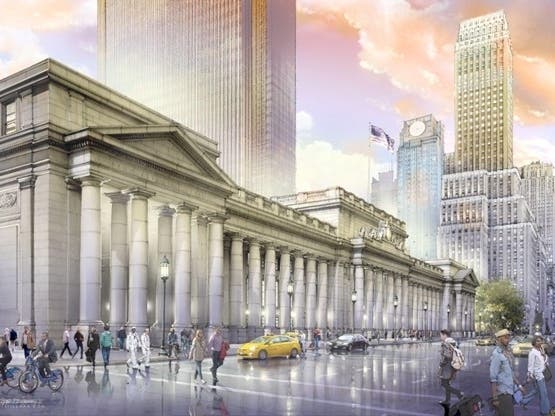
Governor Hochul unveiled her vision for a new commuter-first world-class Penn Station and revitalized surrounding neighborhood that reflects the community's needs and focuses on public transit and public realm improvements. The plan prioritizes the reconstruction of the existing station while the station expansion and the Gateway Project initiatives, both of which the Governor strongly supports, continue on their federally-established timelines. Governor Hochul's new plan thus allows the expedited reconstruction of the existing Penn Station, 60% of whose users are subway and LIRR riders.
The new neighborhood plan comes after several months of collaboration and more than 100 meetings with community stakeholders, government agencies, and elected officials to improve on past plans and establish a new way forward. The plan announced today will also be subject to further public review and today's announcement is part of a larger public process that remains ongoing.
"I'm reimagining the New York City commuter experience. New Yorkers do not deserve what they have been subjected to for decades at Penn Station," Governor Hochul said. "The era of neglecting our Penn Station commuters and the neighboring community is over. New York leaders are expected to offer visionary ideas and take bold actions, and that's exactly what my proposed transformation of Penn Station accomplishes. This plan puts New Yorkers first, delivering the rider-focused transit experience and great neighborhood they deserve. Investing in Penn Station means investing in New York's future as we recover from COVID and build a more sustainable, livable city."
The current Penn Station - the Western Hemisphere's busiest transit hub, serves more passengers than LaGuardia, John F. Kennedy and Newark Airports. The relocation of Amtrak's operations to the new Moynihan Train Hall provides the opportunity to overhaul Penn Station, eliminating the bulk of the first subterranean level to open up the main concourse to natural light, improving retail and other user amenities, increasing safety and security, significantly expanding passenger circulation areas, expanding entrances and exits, and making it easier for passengers to navigate within the station as well as connect to their destinations beyond. The reconstruction of the station is expected to cost between six and seven billion dollars, and will take place between four and five years after the commencement of construction.
In terms of the surrounding development, which will help fund the project, Governor Hochul's new proposal still achieves the necessary revenues while notably scaling down the previous plan, and significantly expanding community and public realm benefits. The new plan takes into account recommendations from the Community Advisory Committee Working Group (CACWG), which worked in consultation with Empire State Development, the Metropolitan Transportation Authority, Amtrak and NJ Transit. The CACWG will continue to inform the plan through its build-out, and the Governor is directing the MTA to actively engage community stakeholders, transit, sustainability, and planning experts, as well as users of Penn Station from across the region, in the process of finalizing the project.
Reimagining the station is part of the Governor's commitment to ensuring equitable transit access and achieving economic development. This will be particularly beneficial for users of the forthcoming Metro-North stations in the East Bronx (Co-op City, Morris Park, Parkchester, and Hunts Point), for whom travel times to and from Midtown will be reduced by up to 50 minutes as a result of Penn Acces.
Image : ReThink Penn Station wants to restore the historic station, including the Seventh Avenue facade which was modeled after St. Peter’s Basilica in Rome. (Design modifications by Richard Cameron, Atelier and Co., rendering by Jeffrey Stikeman)